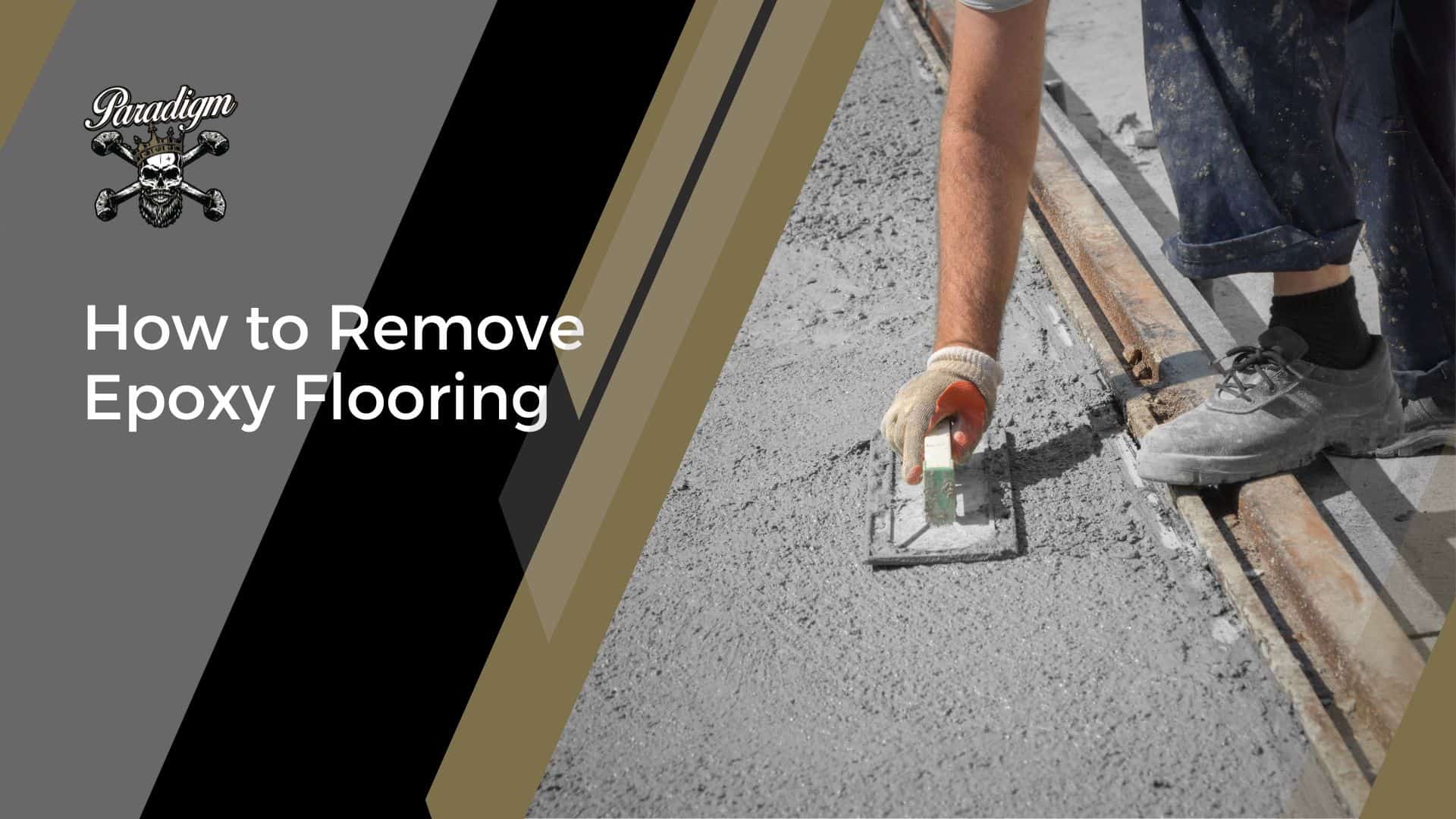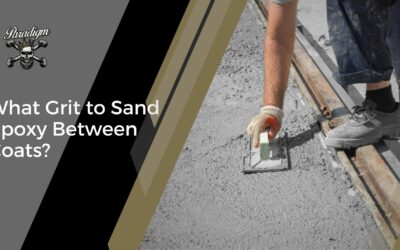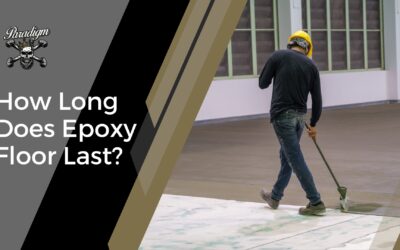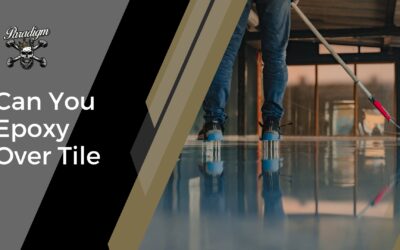Epoxy flooring is a durable and versatile floor coating consisting of epoxy resin mixed with a hardener. Epoxy flooring removal is removing an existing epoxy coating from a concrete substrate. This is often necessary when the epoxy flooring has become damaged, or worn out, or when the need for new flooring arises.
Epoxy flooring removal offers several key benefits in that it allows for updating the space’s appearance, addressing damage or wear, and preparing the substrate for a new flooring system. By removing old or damaged epoxy coatings, homeowners and businesses start fresh for renovation or remodeling projects.
The application process for epoxy flooring typically involves several steps, including surface preparation, primer application, epoxy coating application, and topcoat application.
The time required for epoxy flooring removal varies depending on the method used, the thickness of the epoxy layer, and the size of the area to be removed. The solvent method takes several hours to a few days while sanding or grinding requires a few days to a week. Manual removal by hand needs several days to a few weeks, depending on the size of the area and the number of workers involved.
Table of Contents
What Is Epoxy Flooring Removal?
Epoxy flooring removal is the process of removing epoxy coating from concrete surfaces. This is often necessary when the epoxy flooring has become damaged, or worn out, or when the need for new flooring arises. There are several methods to remove epoxy flooring, including using solvents or strippers, sanding or grinding, and manual removal by hand.
The solvent method involves applying a chemical stripper to the epoxy flooring, which breaks down the bond between the epoxy and the concrete. This is followed by scrubbing the floor with a brush or power washer to remove the epoxy. The sanding or grinding method involves using a machine with abrasive discs or pads to remove the epoxy layer by layer. This method is more aggressive and requires caution to avoid damaging the concrete beneath. Manual removal by hand is a more labor-intensive method, which involves scraping off the epoxy with tools such as scrapers or chisels.
Epoxy is a type of resin that, when mixed with a hardener, forms a strong and durable coating that adheres well to concrete surfaces. It provides a smooth, glossy finish that is resistant to stains, chemicals, and abrasion, making it ideal for high-traffic areas such as garages, warehouses, and workshops.
Proper surface preparation is crucial to ensure adhesion and longevity of the epoxy coating, which involves cleaning, etching, and patching the concrete substrate. Once applied, the epoxy coating cures to form a seamless and durable surface that is resistant to moisture, chemicals, and wear.
Epoxy flooring is widely used in a variety of applications, including garage floors, warehouses, workshops, commercial kitchens, laboratories, and healthcare facilities. Its durability, ease of maintenance, and aesthetic versatility make it a popular choice for enhancing and protecting concrete surfaces in both residential and commercial settings.
Factors to Consider Before Epoxy Flooring Removal
Prior to proceeding with epoxy flooring removal, there are several items to consider:
- Type of Epoxy: Determine the type of epoxy used, such as solvent-based, water-based, or 100% solids epoxy, as this will impact the removal method and difficulty.
- Condition of Flooring: Assess the condition of the epoxy flooring to determine the extent of removal required. Is the epoxy fully intact, or are there areas of damage or delamination?
- Safety Precautions: Prioritize safety by wearing protective gear such as goggles, gloves, and a respirator, and ensure proper ventilation in the work area to minimize exposure to dust, fumes, and chemicals.
- Removal Method: Research and select the most appropriate removal method based on the type of epoxy, condition of the flooring, and desired outcome. Options include mechanical grinding, chemical stripping, shot blasting, scarification, or heat application.
- Equipment and Materials: Gather the necessary equipment and materials for the chosen removal method, such as floor grinders, shot blasters, chemical strippers, or scarifiers, as well as protective coverings and cleaning supplies.
- Environmental Considerations: Consider the environmental impact of epoxy removal, including the disposal of waste materials and any potential hazards associated with chemical strippers or solvents.
- Cost and Time: Estimate the cost and time required for epoxy flooring removal, taking into account factors such as labor, equipment rental, and potential downtime for the space being renovated or remodeled.
What Are the Methods of Epoxy Flooring Removal?
There are several methods for removing epoxy flooring, each suitable for different situations depending on the type of epoxy, thickness, and substrate. Here are some common methods of epoxy flooring removal:
- Mechanical Grinding: This method involves using a floor grinder equipped with diamond grinding discs to mechanically remove the epoxy coating. The grinder effectively grinds away the epoxy layer, leaving a clean substrate surface. It is suitable for thick epoxy coatings and large areas but it is time-consuming and generate dust.
- Shot Blasting: Shot blasting uses a machine that propels steel shots at high velocity onto the epoxy surface, effectively breaking up and removing the coating. It is a fast and efficient method suitable for large areas and thick epoxy coatings. Shot blasting also prepares the substrate for new coatings or finishes.
- Scraping: Scraping involves manually using a floor scraper or putty knife to remove the epoxy coating from the substrate. This method is suitable for small areas or thin epoxy coatings. It requires physical effort and takes longer compared to mechanical methods.
- Chemical Stripping: Chemical stripping involves applying epoxy stripping chemicals to the surface, allowing them to penetrate and break down the epoxy coating. Once softened, the epoxy is scraped or washed away. Chemical stripping is effective for thin epoxy coatings but requires proper ventilation and safety precautions due to the use of chemicals.
- Heat Gun or Torch: Applying heat using a heat gun or torch softens the epoxy coating, making it easier to scrape or peel off. This method is suitable for thin epoxy coatings or small areas. Care must be taken to avoid overheating or damaging the substrate.
- Flooring Removal Machines: Specialized flooring removal machines, such as ride-on scrapers or grinders with scraping attachments, efficiently eliminate epoxy coatings from large areas. These machines are designed for heavy-duty use and speeds up the removal.
- Abrasive Blasting: Abrasive blasting, such as sandblasting or media blasting, involves using abrasive materials propelled at high pressure to remove the epoxy coating. It is suitable for thick coatings and also prepare the substrate for new coatings or finishes.
When choosing a method for epoxy flooring removal, assess the thickness of the epoxy, the size of the area, the substrate condition, and environmental factors such as ventilation and dust control. Proper safety equipment, including respirators, goggles, and gloves, are used when performing epoxy removal to protect against fumes, dust, and chemical exposure. Additionally, consulting with experienced professionals or contractors helps determine the most appropriate method for your particular project necessities.
What Are the Steps Involved in Epoxy Flooring Removal?
The process of epoxy flooring removal involves several steps to ensure safe and effective removal of the epoxy coating from the substrate. Here are the typical steps followed in epoxy flooring removal:
- Assessment and Preparation:
-
-
- Evaluate the condition of the existing epoxy coating, including its thickness, adhesion, and any areas of damage or delamination.
- Clear the area of furniture, equipment, and obstacles to allow for easy access during the removal process.
- Ensure proper ventilation and use of personal protective equipment (PPE) such as respirators, goggles, gloves, and protective clothing.
-
- Selecting the Removal Method:
-
-
- Determine the most suitable method of epoxy removal based on factors such as the type of epoxy, thickness of the coating, substrate material, size of the area, and environmental considerations.
- Choose from mechanical grinding, shot blasting, scraping, chemical stripping, heat application, flooring removal machines, or abrasive blasting, depending on the specific requirements of the project.
-
- Surface Preparation:
-
-
- If using mechanical methods such as grinding or shot blasting, prepare the surface by cleaning it thoroughly to remove dirt, debris, and contaminants.
- Ensure the substrate is dry and free of moisture to prevent adhesion issues during epoxy removal.
-
- Epoxy Removal:
-
-
- Begin the epoxy removal process using the selected method. For mechanical methods, use a floor grinder, shot blasting machine, scraper, or flooring removal machine as appropriate.
- Follow manufacturer guidelines and recommended settings for equipment such as grinding discs, shot blasting media, or scraping tools.
- Work systematically, starting from one corner or edge of the area and progressing methodically to ensure uniform removal of the epoxy coating.
-
- Safety Measures:
-
-
- During epoxy removal, maintain proper ventilation in the area to minimize fumes, dust, and airborne particles.
- Use protective equipment such as respirators, goggles, gloves, and hearing protection to protect against exposure to chemicals, dust, and noise.
-
- Cleanup and Disposal:
-
-
- Once the epoxy coating is removed, clean the area thoroughly to remove any debris, dust, or residues from the removal process.
- Dispose of waste materials, such as removed epoxy chips, dust, or chemical residues, according to local regulations and environmental guidelines.
-
- Substrate Inspection:
-
-
- Inspect the substrate surface after epoxy removal to ensure it is clean, smooth, and free of any remaining epoxy residues, adhesives, or contaminants.
- Address any surface irregularities, cracks, or damage as needed before proceeding with new flooring or coating applications.
-
- Surface Repair and Preparation for New Flooring:
-
- If necessary, repair any substrate damage, cracks, or imperfections before applying new flooring or coating systems.
- Prepare the substrate surface according to the requirements of the new flooring or coating system, including cleaning, leveling, priming, and applying base layers as per manufacturer recommendations.
Adhering to these steps systematically and using the appropriate removal method and equipment, epoxy flooring removal is carried out safely and effectively, preparing the substrate for new flooring or coating installations. Stick to safety protocols, environmental regulations, and manufacturer guidelines throughout the extrication procedure to achieve optimal results.
What are the Safety Precautions to Consider During Epoxy Removal?
Safety considerations are paramount during the epoxy flooring removal to safeguard workers, occupants, and the environment from potential hazards. Here are key safety considerations to keep in mind:
- Personal Protective Equipment (PPE):
-
-
- Wear appropriate PPE, including respirators (for fumes and dust), safety goggles or face shields, gloves, and protective clothing to prevent skin contact with chemicals or abrasive materials.
- Use hearing protection, especially when operating loud machinery such as floor grinders, shot blasting machines, or flooring removal equipment.
-
- Ventilation:
-
-
- Ensure adequate ventilation in the work area to disperse fumes, dust, and airborne particles generated during epoxy removal.
- Use exhaust fans, ventilation systems, or open doors and windows to maintain airflow and reduce exposure to harmful substances.
-
- Chemical Handling and Storage:
-
-
- Follow safety data sheets (SDS) and manufacturer instructions for handling, mixing, applying, and disposing of chemicals used in epoxy removal, such as stripping agents or solvents.
- Store chemicals in properly labeled containers, away from heat sources, ignition points, and incompatible materials.
-
- Dust Control:
-
-
- Use dust containment systems, vacuum attachments, or dust collection equipment to control and capture airborne dust and particles during grinding, blasting, or scraping operations.
- Wet methods, such as wet grinding or wet blasting, reduce dust levels and improve air quality.
-
- Fire Safety:
-
-
- Avoid smoking, open flames, sparks, or hot work activities near areas where flammable chemicals or vapors are present during epoxy removal.
- Have fire extinguishers, fire blankets, and emergency response procedures in place in case of fire hazards.
-
- Slip and Fall Prevention:
-
-
- Keep work areas clean, organized, and free of clutter to reduce the risk of slips, trips, and falls during epoxy removal.
- Use caution signs, barricades, and non-slip floor mats to alert workers and occupants to potential hazards and slippery surfaces.
-
- Equipment Safety:
-
-
- Inspect and maintain all equipment, tools, and machinery used in epoxy removal to ensure they are in proper working condition and meet safety standards.
- Follow equipment operating instructions, safety guidelines, and lockout/tagout procedures when performing maintenance or repairs.
-
- Training and Awareness:
-
- Provide adequate training, education, and awareness programs for workers involved in epoxy removal, covering safety protocols, hazard recognition, emergency procedures, and PPE use.
- Encourage communication, reporting of safety concerns, and participation in safety meetings or toolbox talks to promote a safety-conscious work environment.
Does one eradicate epoxy flooring without damaging the underlying substrate?
Yes, epoxy flooring is removed without causing major destruction to the substrate if proper removal methods and techniques are employed. Mechanical methods such as grinding or shot blasting allow for precise control and gradual removal, minimizing the risk of substrate damage.
Is it possible to rid epoxy flooring from vertical surfaces or walls?
Yes, epoxy flooring is rid from vertical surfaces or walls using specialized tools and equipment designed for vertical applications. Vertical grinding machines, scrapers, or chemical stripping agents formulated for vertical surfaces effectively evict epoxy coatings without compromising wall integrity.
Is epoxy flooring removable from outdoor surfaces exposed to weather elements?
Yes, epoxy flooring is removable from outdoor surfaces exposed to weather elements, but additional precautions and considerations is necessary. Weather conditions such as temperature, humidity, and precipitation impact the expulsion, requiring adjustments in equipment, methods, and scheduling to ensure optimal results.
What are eco-friendly options for epoxy removal that minimize environmental impact?
Eco-friendly options for epoxy removal comprise using biodegradable chemical stripping agents, water-based grinding methods, or abrasive blasting with recycled materials. These techniques reduce chemical exposure, waste generation, and environmental footprint compared to traditional removal techniques.
How is epoxy removal tailored to specific substrate materials such as concrete, wood, or metal?
Epoxy removal techniques are customized based on the substrate material to ensure safe and effective removal. For concrete substrates, mechanical grinding or shot blasting is commonly used. Wood substrates require gentle scraping or chemical stripping to avoid damage, while metal substrates benefit from abrasive blasting or chemical removal methods suited to metal surfaces.
Is epoxy flooring removal combined with surface preparation for new coatings or finishes?
Yes, epoxy flooring extraction is integrated with surface preparation for new coatings or finishes. After epoxy removal, the substrate is cleaned, leveled, and primed as per the requirements of the new coating system, streamlining the transition and ensuring compatibility between old and new surfaces.




